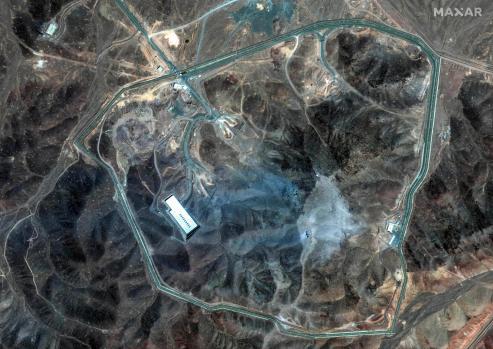LIECHTENSTEIN, Stephanie
VIENNA (AP) After Israel and the United States attacked Iran’s nuclear program, the fundamental question is: What’s left of it?
Related Articles
-
Pentagon leaders cite military tactics to show destruction from US attacks on Iran
-
Iran s Khamenei resurfaces to warn against future US attacks in first statement since ceasefire
-
Today in History: June 26, US Supreme Court legalizes same-sex marriage
-
POWs, abductees, defectors and separated families are the legacy of the Korean War
-
Iranian-backed hackers go to work after US strikes
According to U.S. President Donald Trump, three targets struck by American aircraft were completely destroyed. They were destroyed, according to his defense secretary.
Meanwhile, the U.S. Defense Intelligence Agency released a preliminary report stating that while the strikes caused significant damage to the Fordo, Natanz, and Isfahan sites, they did not completely destroy the facilities.
According to the chairman of the International Atomic Energy Agency, the agency has witnessed significant damage at multiple nuclear sites in Iran, including those three, as a result of Israeli and American strikes. Israel asserts that it has put Iran’s nuclear development many years behind schedule.
Experts and officials are still evaluating the damage, so their conclusions may change.
The location of Iran’s enriched uranium stockpile and the condition of the centrifuges that enrich the fuel are two of the main issues they are attempting to answer.
The IAEA believes that centrifuges at the two enrichment sites in Natanz and Fordo suffered severe damage, though the answer to the first question is unclear.
The world and the IAEA are interested in the condition of the centrifuges and uranium because, should Iran decide to produce a nuclear bomb, producing the necessary fuel would only be a short technical step away.
Iran has consistently insisted that its nuclear program is non-combative.
On June 13, Israel conducted strikes on military and nuclear targets, claiming Iran was attempting to create atomic weapons, that it has enriched large amounts of uranium beyond the levels needed for any civilian use.
On Sunday, the United States joined the assault by dropping 14 bunker-buster bombs on two locations. Iran struck American and Israeli sites in retaliation. Since then, Israel and Iran have reached a ceasefire agreement.
Here are some things we know and don’t know about Iran’s nuclear program.
According to two sources familiar with the assessment, the DIA’s assessment indicates that at least some of Iran’s highly enriched uranium may have been transferred before to the U.S. strikes. The individuals talked on condition of anonymity and were not permitted to discuss the issue in public.
That would imply that the stockpile might have survived in part.
According to the EPA, the assessment was preliminary and will be improved as more data becomes available. Its authors acknowledged that the conclusions might be incorrect and described it as having low confidence.
The White House has referred to the assessment as completely incorrect, using the bombs’ potency to support the president’s claim that the sites were destroyed.
The day Israel began its war campaign, Iran reaffirmed its promise to conceal its enriched uranium in the event of an attack. Canisters containing enriched uranium are easily transportable.
The U.N. nuclear watchdog, the IAEA, said in May that Iran had accumulated 408.6 kilograms (900.8 pounds) of uranium that was up to 60% enriched. According to the U.N.’s yardstick, if it is further enriched to 90%, it would be sufficient to create nine nuclear weapons; nevertheless, a weapon would need further knowledge, such as a detonation device.
According to experts, the stockpile was mostly kept in two locations prior to the war: a heavily protected subterranean enrichment complex in Fordo and underground tunnels at a facility near Isfahan.
On Thursday, U.S. Defense Secretary Pete Hegseth told reporters that he was not aware of any intelligence that he had seen that indicated items were relocated or otherwise not where they were meant to be.
Three days before the U.S. strike, on June 19, satellite footage revealed trucks and bulldozers at the Fordo site.
It is possible that Iran used the trucks to remove nuclear fuel, according to Eric Brewer, a former U.S. intelligence analyst who is currently the deputy vice president of the Nuclear Threat Initiative.
However, senior fellow Jacob Kirkegaard of the Brussels-based Breugel think tank disagreed, saying, “I think that was a decoy more than anything else.”
According to Stephen Wood, senior director at the American satellite imagery and analysis company Maxar Technologies, later satellite data showed that the tube entrances into the underground facility had been covered with dirt before the U.S. bombings. We think that some of the vehicles that were spotted on June 19 were transporting soil for that operation.
Trump used a similar justification.
“The cars and small trucks at the site were those of concrete workers trying to cover up the top of the shafts,” he wrote in a post on his Truth Social network on Thursday. Nothing was removed from the establishment. It would be too heavy and difficult to transport, too risky, and take too long!
The Joint Chiefs of Staff chairman, Gen. Dan Caine, informed reporters that the bombs were dropped on Fordo’s two main ventilation shafts.
He claimed that before to the American attack, Iran tried to cover the shafts with concrete, but the main weapon forcibly removed the cap.
Despite staying in Iran during the war, IAEA inspectors are presently unable to visit any nuclear installations because of safety concerns.
However, IAEA Director General Rafael Mariano Grossi told the agency’s board earlier this week that the agency believes very significant damage is expected to have occurred as a result of U.S. airstrikes at Fordo because of the explosive payload used and the extremely vibration-sensitive nature of centrifuges.
Grossi informed Radio France Internationale on Thursday that the centrifuges there are no longer in use.
If Iran so desires, centrifuges can be used to enrich uranium and eventually raise it to weapons-grade levels.
Centrifuges are also located in Natanz, Iran’s largest enrichment complex.
The IAEA believes that an Israeli hit that cut off power to the site damaged most, if not all, of the centrifuge cascades—groups of centrifuges operating together to enrich uranium more quickly—in its subterranean factory.
According to the agency, its aboveground facility has also been rendered inoperable.
According to the IAEA, strikes also seriously damaged Isfahan, particularly the uranium conversion facility and the uranium metal production factory, which are essential for creating a nuclear bomb.
Israeli Prime Minister Benjamin Netanyahu, like Trump, has said that Iran’s nuclear program has been brought to an end.
The recent strikes, according to the Israel Atomic Energy Commission, have delayed Tehran’s progress toward developing an atomic weapon by years. How they arrived at this conclusion has not been disclosed by Israeli officials.
However, according to those with knowledge of the situation, the DIA evaluation indicated that Iran’s nuclear program had only been delayed by a few months.
Speaking in an interview with Politico, U.S. Secretary of State Marco Rubio confined his assessment to stating that Iran was significantly farther from having a nuclear weapon now than it was prior to the president’s audacious move.
According to Ayatollah Ali Khamenei, the supreme leader of Iran, Trump overstated the significance of the American strikes.
This report was written by Michelle L. Price and Mary Clare Jalonick in Washington and Sam McNeil in Brussels for the Associated Press.
The Carnegie Corporation of New York and the Outrider Foundation support the Associated Press’s coverage of nuclear security. All content is entirely the AP’s responsibility.
See also: https://apnews.com/projects/the-new-nuclear-landscape/ for more AP coverage on the nuclear landscape.












